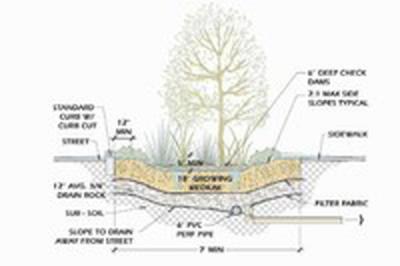Vegetated Infiltration Basins
A vegetated infiltration basin is a landscaped depression that accepts stormwater runoff from impervious surfaces, and is similar to a planter box. The basins allow pollutants to settle and filter out, and also provide the opportunity for infiltration. A vegetated infiltration basin can help fulfill site landscaping requirements.
Specifications
Vegetated infiltration basins are designed to have a storage depth of 9 to 18 inches and maximum side slopes of 3 horizontal to 1 vertical. The minimum flat bottom width is 3 feet, with a minimum total bottom width of 9 feet. The basin must be designed to empty within 24 hours of a storm event.
If stormwater is piped into the vegetated basin, splash guards or other energy dissipaters (e.g. river rock) must be provided to minimize potential erosion. Surface flow inlets should be properly sized to prevent clogging (minimum 12 inch cut spaced 10 feet on center). An overflow pipe should be provided set at a minimum 9 inches above the bottom of the basin and a minimum of 6 inches below the top of the basin. The overflow must be piped to an approved conveyance system.
Infiltration basins are required to be set back 5 feet from property lines, 10 feet from building foundations, and 100 feet from downstream slopes of 10%. For each additional percent slope over 10% and up to 30%, the basin shall be set back an additional 5 feet. Infiltration basins may not be located near slopes greater than 30%.
Planting Specifications
Plant material required per 300 square feet of facility area:
- 1 evergreen or deciduous tree (planted around the perimeter of the basin)
- 4 large shrubs/small trees (3 gallon containers or equivalent)
- 6 shrubs/large grass-like plants (1 gallon containers or equivalent)
- Ground cover to be planted 1 per 12 inches on center or seeded/sod
At least 50% of the area shall be grass or grass-like plants (sedges, rushes, etc.). Wildflowers, native grasses, and ground covers used in the facility should require minimal or no mowing.
A minimum of 4 different species of trees and shrubs must be used. Topsoil shall be added to the top 12 inches of the swale, or the soil shall be amended with organic material to support plant growth.
Maintenance Requirements
- Inlet must be cleared if conveyance capacity is plugged, or if water begins to short circuit the basin
- Rock splash pads to be inspected and repaired if necessary or if erosion is occurring in the basin.
- Vegetation to be inspected and maintained as appropriate, including replacing diseased or dead vegetation upon discovery.
- Invasive and nuisance vegetation to be removed upon discovery.
- Sediment and debris (grass clippings, dead leaves, organic matter, etc.) exceeding 4 inches in depth to be removed at least every 2-5 years, or sooner if function is impacted.
- Trash to be removed from basin weekly
- Overflow spillway to be inspected and cleared when 25% of the conveyance capacity is plugged
- If basin does not drain within 48 hours of a storm, sources of possible clogging to be identified and corrected
Vegetated Infiltration Basin Locations in Sandy
None at this time
Resources Used
- City of Gresham Department of Environmental Services Stormwater Division. Water Quality Manual. Summer 2003.
- City of Oregon City. City of Oregon City Stormwater and Grading Design Standard; Chapter 5 of City Code.
- City of Portland Bureau of Environmental Services. Stormwater Management Manual. July 1, 1999; Revised 2004
- Clean Water Services. Design and Construction Standards for Sanitary Sewer and Surface Water Management. March 2004.
- Sound Native Plants. Environmental Conditions Favorable for Establishment of Outplanted/Transplanted Plants. 2000.
- Additional information and resources are available on the City of Portland Bureau of Environmental Services web page


